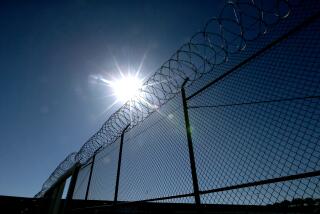Gov. Jerry Brown vows fight with judges over prisons
- Share via
SACRAMENTO — Escalating a dispute with the courts over California’s troubled prison system, Gov. Jerry Brown on Friday fired back at federal judges who threatened to hold him in contempt, vowing to “litigate until the Supreme Court tells us that we’re not on the right track.”
The governor, the target of a scathing ruling Thursday that gave him three weeks to file a plan for meeting a court-ordered cap on the prison population, said he cannot remove thousands more convicts from California lockups without a spike in crime.
He is already fielding complaints from county authorities straining to handle their inmate loads since he eased prison crowding by ordering many low-level offenders and parole violators to be kept in local jails.
“If they feel bad now, wait till another 10,000 hit the streets under orders of the federal courts,” said Brown, who is traveling in China with a trade delegation this week. “That’s not going to happen, though, until we appeal all the way to the U.S. Supreme Court.”
The high court nearly two years ago upheld the judges’ order that the prison population be capped to end “needless” prisoner deaths, but it left open the possibility of modifying the limits.
The governor said Friday that he would personally tour the state’s prisons and “listen and read what the critics say.” But, he added, “I have to tell you the constitutional standard is deliberate indifference, and as far as I know there is nobody deliberately indifferent to the health needs of the California prisoners.
“And if I find such a person,” Brown said, “he will be fired on the spot.”
He defended improvements made in the corrections system in recent years and lauded those who run the lockups: “California prisons are run by honorable men and women. They’re doing the best job possible.”
Some legal scholars say the odds of a Supreme Court ruling in favor of the governor at this point are long, and Brown ultimately may have little choice but to move or release inmates.
Brown and the judges are “going eyeball to eyeball and hoping one of them is going to blink,” said Malcolm Feely, a law professor at UC- Berkeley and author of a book about federal courts and prison reform.
The dispute between Brown – a lawyer and California’s former attorney general -- and the three judges who issued this week’s ruling has become acrimonious in recent months.
In January, Brown declared the prison crisis over and requested an end to court oversight of inmate healthcare, which costs the state roughly $1 billion each year. The judges, who have ruled that overcrowding caused unconstitutionally poor healthcare for prisoners, said no Thursday and wielded contempt threat.
The court’s population target requires the state to reduce the number of prisoners by 9,500 by the end of the year, and the judges faulted Brown and other state officials for not making more progress.
“At no point over the past several months have defendants indicated any willingness to comply, or made any attempt to comply, with the orders of this court,” their opinion said. “In fact, they have blatantly defied them.”
Brown is not the first governor the judicial panel -- U.S. District Judges Thelton Henderson and Lawrence Karlton and U.S. 9th Circuit Court of Appeals Judge Stephen Reinhardt in Los Angeles -- has threatened with contempt. Arnold Schwarzenegger also faced sanctions after the jurists grew impatient with his administration’s lack of progress on overcrowding.
With the court prepared to impose a plan of its own, the Schwarzenegger administration began to bend. It allocated more funds to the corrections system, made plans to move more inmates to private facilities and worked with lawmakers on reducing sentences for minor offenses.
If the judges do hold Brown in contempt, that will most likely mean substantial fines against the state for every day it fails to comply with court orders, said Erwin Chemerinsky, dean of the law school at UC Irvine.
A West Virginia court recently ordered officials in that state to pay what amounts to $20,000 a day in contempt fines during a case involving the care of patients at its psychiatric hospitals.
Brown has said that none of his options for cutting overcrowding are good for the state.
One is sending inmates to other states. That would be costly, and Brown has already pledged to return 8,500 inmates currently housed in other states to facilities in California to save money. Another solution is letting inmates go free, reducing their sentences with credit for good behavior or for attending classes, or sending home the sick or elderly. Lawmakers could need to approve such changes.
Reducing sentences for certain drug crimes is also a possibility. Legislation would be required for such changes but would be unlikely to remove enough prisoners from the system to put the state incompliance by the end of the year.
“We have a patchwork of penal code passed by lawmakers trying to get a name for being ‘tough on crime’ so they have those bragging rights at the next election,” said Robert Sanger, president of the California Attorneys for Criminal Justice. “The court has now given cover to legislators to do the right thing.”
Administration officials argue that the state has already overhauled its sentencing laws, and further changes would create a public safety risk.
Jonathan Simon, a law professor at UC Berkeley, said the Supreme Court could lighten the pressure by giving the state more time to meet the population cap. He noted the high court backed the limit only narrowly, in a 5-4 vote.
“Will Justice Kennedy look at the progress … and say good enough?” Simon said, referring to the judge usually considered the court’s swing vote. “Quite possibly.”
Others said they doubted the Supreme Court would even agree to revisit the case, decided less than two years ago on largely the same facts.
“I think it is very unlikely,” Chemerinsky said.
Times staff writer Anthony York in Shanghai contributed to this report.
More to Read
Sign up for Essential California
The most important California stories and recommendations in your inbox every morning.
You may occasionally receive promotional content from the Los Angeles Times.












